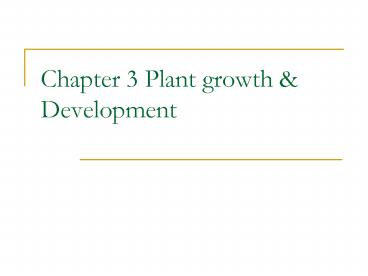Chapter 3 Plant growth - PowerPoint PPT Presentation
1 / 13
Title:
Chapter 3 Plant growth
Description:
1st group of plant hormones to be discovered, mid 1930's. Adventitious root initiation ... Overcoming the cold requirement for some plants. Cytokinins ... – PowerPoint PPT presentation
Number of Views:31
Avg rating:3.0/5.0
Title: Chapter 3 Plant growth
1
Chapter 3 Plant growth Development
2
Growth Factors
- Chemical Energy
- Photosynthesis
- Respiration
- Net Photosynthesis
- Temperature
- Zone of tolerance
- Optimum temperature
- Nutrients water
3
Growth Substances
- Auxins-
- 1st group of plant hormones to be discovered,
mid 1930s - Adventitious root initiation
- Weed control (2-4D)
- Inhibition of stem sprouting
- Tissue culture
4
Gibberellins-
- Increasing fruit size of seedless grapes
- Stimulating seed germination seedling growth
- Promoting male flowers in cucumbers
- Overcoming the cold requirement for some plants
5
Cytokinins-
- No important agriculture use at this time.
- DNA RNA
6
Ethylene
- Fruit ripening
- Flower initiation
- Changing sex expression (female flowers in
cucumbers pumpkins) - Degreening oranges, lemons grapefruit
- Harvest aids
7
Inhibitors
- Abscisic Acid
- Synthetic
- Used to regulate plant growth
8
Growth inputs quality
- Timing
- Amounts
9
Patterns of plant growth development
- Vegetative Phase
- Reproductive Phase
10
Temperature Vernalization
- Some plants need lower temperatures for flower
induction - Temperature ranges are 32-500 F
- Examples are cereal grains (wheat, barley, rye)
- Some can be induced to flower by colder temps
(spinach, peas, lettuce) - Must reach a maturity before vernalization can
begin - Hormone induced (gibberellins)
- Look at table 3.1
11
Light Photoperiod
- Some plants needs a certain number of hours of
day length to flower - Short day plants (i.e. poinsettias, strawberries,
mums) need long nights uninterrupted to flower - Long Day plants (i.e. spinach sugar beets) need
short nights - Day neutral (i.e. tomatoes)
12
- Floral stimulus is transmitted form leaves to
meristem - Vegetative to flowering
- Different photoperiods needed to induce
- Once apex has changed to flower tissue
irreversible - Flower initiation to anthesis varies.
13
Flowering Response to Photoperiod
- length of day
- Long Day Plants greater than13 hours
- Short Day Plants less than12 hours
- Day Neutral Plants no response
- Look at table 3.2 3.3































